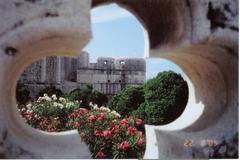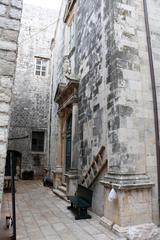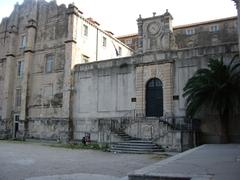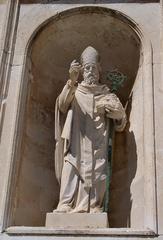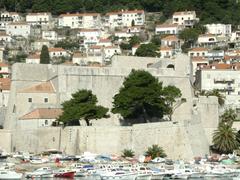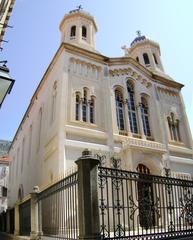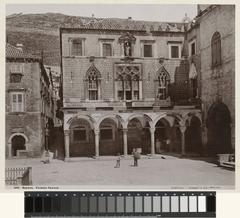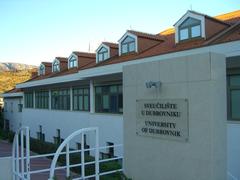
Franjo Tuđman Bridge: Comprehensive Visitor Guide, Hours, Tickets, and Historical Context
Date: 04/07/2025
Introduction
The Franjo Tuđman Bridge is a modern engineering marvel and one of Dubrovnik’s most iconic landmarks. Spanning the picturesque Rijeka Dubrovačka river at Dubrovnik’s western gateway, it serves not only as a vital transport link but also as a symbol of Croatia’s resilience, national unity, and progress. Since its official opening in 2002, the bridge has become a favorite destination for tourists, photographers, and locals, offering breathtaking panoramic views of the Adriatic Sea, the city skyline, and the surrounding mountains.
Open 24 hours a day with no entrance fees, the bridge is fully accessible to pedestrians, cyclists, and vehicles. Recent upgrades—most notably an advanced RGBW LED lighting system—have enhanced its nighttime beauty and environmental sustainability, making the Franjo Tuđman Bridge a highlight of any Dubrovnik itinerary (Structurae; Dubrovnik Tourist Board; Filix Lighting).
This detailed guide will cover the bridge’s history, architecture, visitor information, nearby attractions, and practical travel tips to help you plan a memorable visit.
Table of Contents
- Historical Context and Construction
- Symbolism and Naming
- Architectural Features and Engineering Innovations
- Cultural Impact and Visitor Experience
- Visiting Information (Hours, Access, Accessibility, Travel Tips)
- Nearby Attractions and Gruž Neighborhood
- Lighting Evolution and Environmental Initiatives
- Practical Tips for Visitors
- Frequently Asked Questions (FAQ)
- Visuals and Additional Resources
- Summary and Conclusion
- Sources
Historical Context and Construction
Planning and Construction
The concept for a bridge at this location emerged in the late 20th century, driven by Dubrovnik’s growing need for improved transportation infrastructure. Prior to its construction, access to Dubrovnik from the north involved a lengthy and congested detour along the D8 state road. Construction began in 1998, in the wake of the Croatian War of Independence, as part of the nation’s broader post-war modernization efforts. The bridge was completed and opened in May 2002, at a cost of approximately 252 million Croatian kuna (Structurae; Croatian Roads).
Symbolism and Naming
The bridge was named after Franjo Tuđman, Croatia’s first president, whose leadership was pivotal during the country’s struggle for independence in the 1990s (Britannica). The naming was both a tribute to his legacy and a manifestation of national pride. The bridge stands as a metaphor for unity, physically linking Dubrovnik with the rest of Croatia and symbolically representing the country’s resilience and forward-looking spirit (Total Croatia News).
Architectural Features and Engineering Innovations
Structural Design
The Franjo Tuđman Bridge is a cable-stayed structure, notable for its single, slightly inclined pylon that rises 141.5 meters above sea level. The total bridge length is 518 meters, with a main span of 304.5 meters. The deck is 23.8 meters wide, accommodating two lanes of traffic in each direction and pedestrian walkways on both sides. The fan arrangement of high-strength steel cables radiates from the pylon, providing both structural stability and an aesthetically striking silhouette (Structurae).
Engineering Challenges
Given Dubrovnik’s coastal location, the bridge was engineered to withstand strong winds, thunderstorms, and seismic activity. Advanced fixing details and custom brackets were used for lighting fixtures to handle vibrations and dynamic loads. The cable-stayed design minimized the number of support piers, reducing environmental impact on the Rijeka Dubrovačka below (Filix Lighting).
Materials and Construction
Constructed by Walter Bau AG and Konstruktor (Split), the bridge utilizes reinforced concrete and steel for durability and corrosion resistance. The project’s technical and environmental challenges required innovative engineering solutions, earning the bridge recognition within the international engineering community.
Cultural Impact and Visitor Experience
Iconic Status and Local Integration
Since its completion, the bridge has become one of Dubrovnik’s most photographed landmarks, especially at sunset when its cables and pylon are illuminated against the Adriatic backdrop. It is integrated into local life, hosting community events like charity runs and cycling races, and is frequently featured in educational tours about modern Croatian infrastructure and history (Dubrovnik Tourist Board).
Symbol of Resilience and Unity
The bridge’s completion marked a milestone in Dubrovnik’s post-war recovery and Croatia’s national renewal. For many, it is a daily reminder of the city’s enduring spirit and the country’s aspirations for progress and openness.
Visiting Information
Visiting Hours
The Franjo Tuđman Bridge is open to the public 24 hours a day, seven days a week. There are no tickets or entrance fees required for pedestrians, cyclists, or vehicles.
Accessibility
Pedestrian walkways on both sides of the bridge are well-maintained and wheelchair accessible, though assistance may be needed on approach ramps. The bridge is safe for walking and cycling, but visitors should be cautious during strong winds or adverse weather.
Getting There
The bridge is easily accessible by car, taxi, local buses, bicycle, or on foot from Dubrovnik’s city center. Bus lines 1A, 1B, and 3 connect the Old Town and Lapad to the Gruž area, near the bridge’s southern end. Parking is available but limited, so visiting during off-peak hours is advisable.
Travel Tips
- Best Times: Early morning or late afternoon for ideal light and fewer crowds.
- Photography: Bring a wide-angle lens; best vantage points are the pedestrian walkway, Port of Gruž, and nearby hills.
- Weather: Check forecasts for wind conditions; the bridge can be exposed during storms.
- Nearby Services: No amenities on the bridge itself, but cafes, shops, and restrooms are available in Gruž.
Nearby Attractions and Gruž Neighborhood
Gruž District
Located at the bridge’s southern end, Gruž is a lively port area with a daily market, local eateries, and an emerging arts scene. Highlights include:
- Gruž Market: Fresh produce, seafood, cheese, and local specialties.
- Dubrovnik Beer Company: Local craft brewery with tasting tours.
- TUP Art District: Revitalized industrial area featuring concerts, exhibitions, and the Red History Museum.
Coastal Promenade
The 2.5-kilometer promenade from Gruž to Lapad Bay offers scenic walks along the Adriatic, lined with palm trees, benches, and seaside cafes.
Boat Tours
Gruž harbor is the departure point for ferries and cruises to the Elaphiti Islands, Mljet, and Korčula, making it easy to combine a bridge visit with island exploration.
Lighting Evolution and Environmental Initiatives
Historical Lighting
The original decorative lighting installed in 2002 became outdated over time, prompting Croatian Roads to commission a major upgrade.
2025 Lighting Upgrade
The bridge now features 1,011 Filix Hemera RGBW LED lamps controlled via DMX technology. This €790,000 upgrade allows for programmable color displays to mark special events and holidays, enhancing both safety and visual appeal (Filix Lighting; The Dubrovnik Times).
Environmental Protection
The lighting system is energy-efficient and designed to minimize light pollution, protecting local wildlife and the night sky. Directional optics prevent glare and unnecessary light spill, aligning with Dubrovnik’s sustainability goals.
Practical Tips for Visitors
- Best Viewing: After sunset during city festivals or national events when special lighting is on display.
- Photography: Use a tripod for night shots; top spots include Port of Gruž and approach roads from Mokošica.
- Accessibility: Bridge walkways are wheelchair-friendly.
- Etiquette: Avoid shining extra lights at night to help preserve the environment.
Frequently Asked Questions (FAQ)
Q: Are there entrance fees or tickets to visit the Franjo Tuđman Bridge?
A: No, the bridge is freely accessible at all times.
Q: Is the bridge wheelchair accessible?
A: Yes, the pedestrian walkways are flat and accessible; some approach ramps may require assistance.
Q: Can I walk or cycle across the bridge at any time?
A: Yes, pedestrian and cycle access is available 24/7.
Q: Are guided tours available?
A: While there are no official bridge-only tours, many Dubrovnik city tours include the bridge as a highlight.
Q: What nearby attractions should I visit?
A: Gruž Market, Dubrovnik Beer Company, TUP Art District, and the coastal promenade, as well as the UNESCO-listed Old Town.
Q: Is the bridge safe in bad weather?
A: The bridge is designed for safety, but caution is advised during strong winds or storms.
Visuals and Additional Resources
- Dubrovnik Tourist Board’s official gallery
- Interactive map – Franjo Tuđman Bridge location
- Virtual 360° tour of the bridge
Summary and Conclusion
The Franjo Tuđman Bridge stands as a testament to Croatia’s engineering prowess and enduring spirit. Its elegant design, strategic importance, and recent technological upgrades make it a must-see for anyone visiting Dubrovnik. Accessible, beautifully lit, and surrounded by vibrant neighborhoods and historical sites, the bridge is both a practical transport link and an inspiring destination in its own right.
Plan your visit today, and consider pairing your bridge walk with a tour of the Gruž district, a ferry trip to the Elaphiti Islands, or an evening stroll along the coastal promenade. For up-to-date travel tips, downloadable guides, and event information, download the Audiala app and follow us on social media.
Sources
- Structurae: Franjo Tuđman Bridge
- Britannica: Franjo Tuđman
- Total Croatia News: Franjo Tuđman Bridge
- Filix Lighting: Hemera Dubrovnik Bridge
- The Dubrovnik Times: Bridge Lighting Upgrade
- Dubrovnik Tourist Board: Franjo Tuđman Bridge
- UNESCO World Heritage Centre: Dubrovnik







